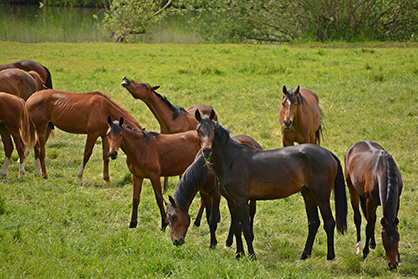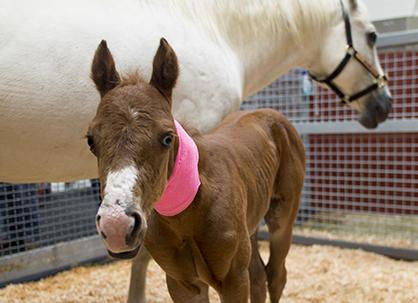Equine West Nile Threat Increases During Peak Mosquito Season (July-October)
July 14, 2016 Comments Off on Equine West Nile Threat Increases During Peak Mosquito Season (July-October)
Horses are at highest risk of contracting West Nile virus during peak mosquito activity, which occurs July through October in the United States.1 However, there’s still an opportunity to help protect horses against this life-threatening disease.
Continue reading …Veterinarians Discover Pistacia Trees Toxic/Deadly to Horses if Ingested
July 13, 2016 Comments Off on Veterinarians Discover Pistacia Trees Toxic/Deadly to Horses if Ingested
UC Davis veterinarians are warning horse owners to keep their animals away from Pistacia orchards, as the leaves and seeds of this genus can cause hemolytic anemia, and be fatal, if ingested.
Continue reading …
Horses carry 60 to 65 percent of their weight on their forehand while moving.2 And the faster a horse moves, the more stress on the joint. To put this in perspective, a 1,000-pound horse is carrying approximately 625 pounds by the front legs.
Continue reading …Piles of Grass Clippings Are NO Tasty Treat For Your Horse!
July 8, 2016 Comments Off on Piles of Grass Clippings Are NO Tasty Treat For Your Horse!
Grass clippings that stay on the pasture after mowing, where they can dry in small amounts, are generally not a problem. But never gather them into piles to feed them to your horse. Here’s why…
Continue reading …Conditioning Your Horse For Gaming Events
June 28, 2016 Comments Off on Conditioning Your Horse For Gaming Events
After you have made sure your horse is sound and ready for work, begin with short conditioning sessions at the walk and trot only and mostly in straight lines and soft curves or serpentines for 20 to 30 minutes per day. This will allow your horse to build up his muscles slowly while allowing all of the horse’s muscles, tendons and ligaments to stretch. Asking a horse that is not conditioned properly to perform small, tight turns will put undue stress on under-developed muscles, tendons and ligaments and could cause injury.
Continue reading …First 360 Degree Virtual Reality Video for Veterinary Education
June 23, 2016 Comments Off on First 360 Degree Virtual Reality Video for Veterinary Education
“Imagine learning about a rare or complex surgery as if you’re right there at the operating table,” Tayce said. “We could create virtual environments to supplement student learning. We are only scratching the surface of possibilities.”
Continue reading …10 Tips to Protect Your Horse During the Summer Horse Show Heat
June 17, 2016 Comments Off on 10 Tips to Protect Your Horse During the Summer Horse Show Heat
Heatstroke obviously can happen if exercising in hot conditions, but be aware that it can also happen if standing in a hot stall or trailer. Signs of heat stroke can include: An elevated heart rate that does not return to normal in a reasonable period of time, excessive sweating OR lack of sweating, temperature that persists above 103 degrees F, depression, lethargy, signs of dehydration: dry mucous membranes, poor capillary refill, and poor skin turgor.
Continue reading …High Flying Filly: Sick 2-Day-Old Foal Flown by Chartered Aircraft to Receive Emergency Care
June 15, 2016 Comments Off on High Flying Filly: Sick 2-Day-Old Foal Flown by Chartered Aircraft to Receive Emergency Care
On May 24th, a very sick filly was flown by chartered aircraft from Walla Walla, Washington to Pullman, Washington, a distance of 72 miles by air, to receive immediate veterinary care from the Washington State University College of Veterinary Medicine. The foal, nicknamed “Patsy,” had been born just one day earlier but wasn’t nursing and had quickly taken a turn for the worse.
Continue reading …Understanding Antioxidant Supplements for Horses
June 14, 2016 Comments Off on Understanding Antioxidant Supplements for Horses
During exercise, horses inhale more oxygen than usual to meet the demand of their muscles. Along with supporting the muscular oxygen needs, free radicals are produced and horses suffer oxidative stress. Damage by free radicals is associated with aging and various diseases.
Continue reading …SmartPak Conducts Successful Research on Vitamin E Pellets
June 10, 2016 Comments Off on SmartPak Conducts Successful Research on Vitamin E Pellets
“For optimum muscular and neurological health, dietary vitamin E is a critical component to your horse’s own antioxidant defense systems,” says Dr. Lydia Gray, SmartPak’s Staff Veterinarian/Medical Director and primary investigator. “Through this 14-day study, we were able to conclusively show that our “natural” vitamin E supplement is well-absorbed by horses, rapidly reaching recommended levels in the body.”
Continue reading …







